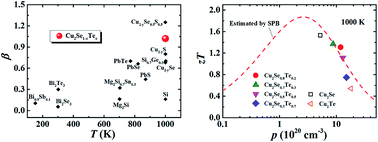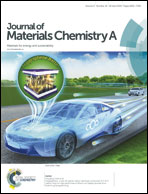Thermoelectric properties of Cu2Se1−xTex solid solutions
Abstract
Binary Cu2Se and Cu2Te have gained great attention recently because of their interesting and abnormal physical properties, such as ultralow thermal conductivity, high carrier mobility, large effective mass of carriers and excellent thermoelectric performance. In this study, we find that these two compounds are completely miscible throughout the studied composition range. The trigonal structure of Cu2Se is maintained when the Te content x is 0.2, but a new trigonal structure is formed when the Te content x is between 0.3 and 0.7. The carrier concentration is greatly improved when increasing the Te content in Cu2Se1−xTex solid solutions, resulting in a much reduced electrical resistivity and Seebeck coefficient in the whole temperature range as compared with those of binary Cu2Se. The total thermal conductivity is inversely increased due to the contribution from enhanced carrier thermal conductivity. As a result, the overall thermoelectric performance of Cu2Se1−xTex solid solutions lies between Cu2Se and Cu2Te. We also find that the quality factor of Cu2Se1−xTex is higher than those of most typical thermoelectric materials. Thus the thermoelectric performance can be further improved if the intrinsically high hole carrier concentrations can be reduced in Cu2Se1−xTex.



 Please wait while we load your content...
Please wait while we load your content...